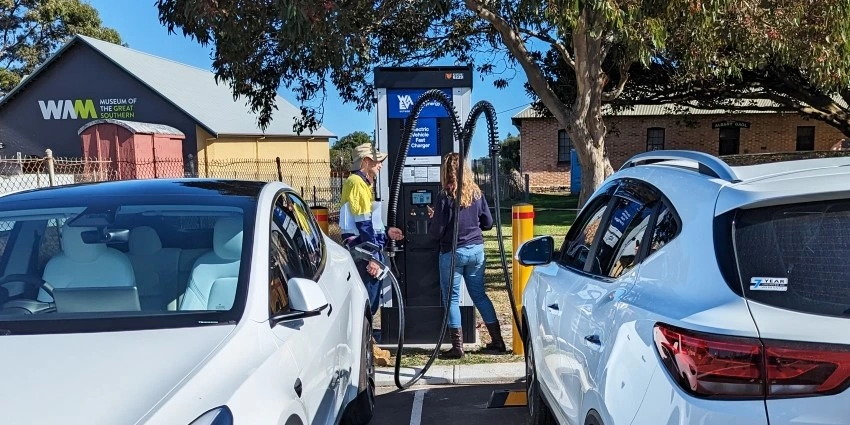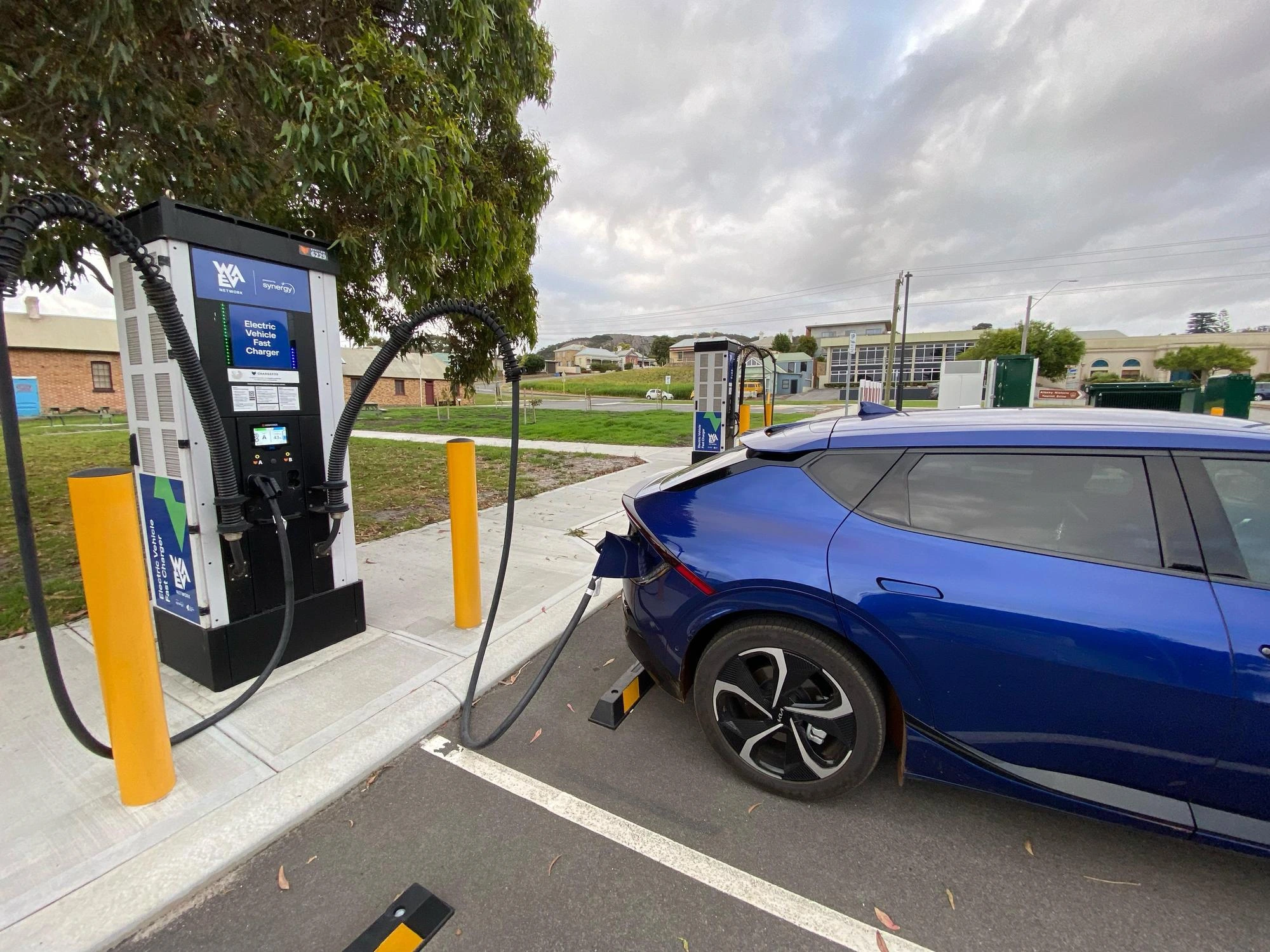Ever thought about cruising through Albany’s hills in an EV, sipping coffee while your car charges? Electric vehicles (EVs) are booming in Australia, and Albany is joining the charge with new stations popping up across the city. In fact, the City of Albany now lists 12 EV charging locations – including two 150 kW DC fast chargers – to keep you powered up.
This guide covers everything from finding those Electric Car Charging Stations in Albany to charging smarter at home or on the road, so you can plan your next drive worry-free (and cheaply) for your next Aussie road trip.
Albany has truly put EV charging on the map. The WA EV Network now stretches through Albany with dual 150 kW fast chargers at the Old Gaol Museum carpark, letting up to four cars charge simultaneously. Payment is easy via credit card, RFID or app, so any EV driver can fuel up without fuss.
Other public chargers in Albany include a Tesla Destination charger at the library and AC chargers at McDonald’s Orana and The Sandalwood Factory. All up, 12 convenient stations – public and private – are scattered across town.
You can even search Google for Electric Car Charging Stations in Albany, or check the City of Albany’s website for a full map of local chargers. Thanks to this network (and the nationwide EV boom), you can drive from Albany to Kalgoorlie or Perth without range anxiety – the future is now on the open road.
Types of EV Chargers
There are different “flavours” of chargers, from a slow wall outlet to an ultra-fast Tesla Supercharger. For example, a standard 10 A home socket (Level 1) delivers only ~2.4 kW, adding roughly 10 km of range per hour of charge.
A dedicated home/public charger (Level 2, 7–22 kW) is much faster: typically 30–80 km of range per hour. At the high end, public DC fast chargers (50–150 kW) are the sprinters – they can add up to ~320 km of range in about 30 minutes. In short, faster chargers mean quicker pit-stops. But even a “slow” charger can top you up if you have time (e.g. overnight).
| Charger Type | Power (kW) | Approx Range Added |
|---|---|---|
| Standard power point (Level 1) | ~2.4 | ~10 km per hour |
| Home/Public fast charger (Level 2) | 7–22 | ~30–80 km per hour |
| DC Fast Charger (public) | 50–150 | Up to ~320 km in 30 min |
Charging at Home: Easy and Cheap
Most EV drivers charge at home – it’s as simple as plugging in your phone overnight. In fact, around 80% of EV charging in Australia happens at home, because it’s convenient and cheap. Off-peak electricity rates (often at night) can be as low as $0.20–$0.30 per kWh. To illustrate, fully charging a 60 kWh battery (common in many EVs) costs about $12–$18 at home – that’s only around $3–$5 per 100 km of driving (petrol is usually $12–$15/100 km by comparison).0
If you have rooftop solar, you can charge your EV during daylight for free (zero-cost charging when the sun is shining). If you install a dedicated home charger (7–22 kW), your car will charge 3–10× faster than a normal outlet. Many home chargers let you schedule charging: you can set it to run overnight or when renewables are abundant, shaving even more off your bills.
One pro tip: you don’t need to charge to 100% every day. Keeping the battery between about 20% and 80% is often recommended for longer battery life. So most owners do a “top-up” charge overnight and save the full charges for longer trips.
Public Charging: Tips & Etiquette
When you’re out on the road, public EV chargers are your travel buddies. First thing: bring your own cable for AC chargers. In Australia, many public Level 2 chargers are socket-only, so you need a compatible Type 2 cable (or adapter) to plug in. Albany’s new WA EV Network fast chargers have built-in plugs (CCS/CHAdeMO) for DC charging, but at slower sites (like the library or McDonald’s), you must plug the cable in yourself.
Charging at a public station is easy: park, connect the cable, and follow the instructions on the screen or app. The charger will show when it’s active. While your car juices up, relax – maybe grab a snack or stretch your legs. Keep an eye on charging speed, though: DC chargers slow down above ~80% state-of-charge, so it’s often fastest to unplug around that point.
Crucially, when you’re done charging, move your car. Just like at a petrol station, hogging a charger can inconvenience other EV drivers (and some places even charge an “idle fee” if you linger). Treat EV spots like quick parking bays – plug in, power up, then pull out once you’re topped up.
You’ll find it easy to locate EV chargers via smartphone. Google Maps now shows EV charging points, and dedicated apps (like PlugShare or Chargefox) list all the chargers in town. These apps also tell you if a charger is in use or out of order, so you can plan accordingly.
PlugShare’s map highlights all Electric Car Charging Stations in Albany, giving you a complete view of nearby options. In short, check the app, drive there, and plug in – EV charging is user-friendly once you know the drill.
Smart Habits for Using Electric Car Charging Stations in Albany
Want to get the most out of Electric Car Charging Stations in Albany? A few smart habits can make charging cheaper, easier, and kinder to your car’s battery. Here’s a quick list worth remembering:
- Plan your stops ahead: Use PlugShare or Google Maps to avoid waiting at busy chargers.
- Charge at night when possible: Off-peak electricity is cheaper and cleaner.
- Keep battery between 20%–80%: Helps extend battery life and avoids long charging waits.
- Don’t treat fast charging as daily fuel: Save DC fast charging for road trips, not every day.
- Check charger availability before you leave: Apps show live status and prevent wasted trips.
- Be considerate of others: Move your car once charged so everyone gets a fair go.
By following these habits, you’ll reduce costs, protect your EV’s battery health, and keep the charging experience stress-free for yourself and others.
Planning Your EV Trips
A bit of planning makes EV travel smooth. With WA’s EV highway network now in place, you can drive far without worry. For example, if you’re heading from Albany to Perth (~415 km), just aim to stop at chargers roughly every 150 km. Combine charging stops with breaks you’d need anyway – coffee, lunch or a quick walk – and the time passes quickly.
Remember: typical EVs today go 300–500 km on a full charge, so even skipping a charger leaves a buffer. Many EV owners (myself included) simply top up whenever they park – at home, work or shops. I often plug in at work to add a quick 20 km of range, making busy mornings much less stressful.
This habit keeps the battery topped off. With these small top-ups plus an overnight charge, range anxiety quickly fades – you rarely leave home below 80%.

Cost and Savings
Let’s talk dollars. Home charging is very affordable: off-peak rates around $0.20–$0.30/kWh translate to roughly $12–$18 for a full 60 kWh charge. By contrast, petrol for 100 km of driving can be $12–$15. Over a year, that’s serious savings. Public charging can cost more per kWh, but it’s often worth it for convenience or speed. Here are a few money-saving tips:
- Charge at off-peak times: If you can, plug in at night or whenever your plan has lower rates. Some energy companies even offer EV-friendly tariffs.
- Use solar: If your home has solar panels, charge in daylight. You’ll be using free electricity and possibly even feeding excess back to the grid (the holy grail of green charging).
- Compare networks: Some charging networks have memberships or app credits that reduce prices. Plan ahead if you know a certain network is cheaper.
- Run errands while charging: Many public chargers are at shopping centres or cafes. If possible, pick a slow 7–22 kW charger at a mall (cheaper rates and maybe free parking) and let your car top up while you shop or eat.
- Stay updated: Keep an eye on local news and maps – new Electric Car Charging Stations in Albany are added regularly, so you always have more options.
All up, EVs are kind to your wallet. Industry analysts note that even accounting for higher sticker prices, the much lower fuel and maintenance costs make EVs more economical long-term. In Albany (and Australia at large), as more drivers switch to electric, charging stays competitive thanks to rebates, subsidies and the growing network.
Frequently Asked Questions
Where are the Electric Car Charging Stations in Albany?
Albany has 12 charging locations. Key spots include the WA EV Network fast chargers at the Old Gaol (Festing St), the Tesla Destination Charger at the Albany Public Library, and outlets at McDonald’s Orana and The Sandalwood Factory. Apps like PlugShare list these (and any new) chargers on a map.
How long does it take to charge an EV?
It depends on the charger. At Albany’s 150 kW DC fast charger you can often get ~80% battery in 20–30 minutes (enough for 300+ km in many EVs). A 7 kW public charger might add ~40 km of range per hour, whereas a home power point adds only ~10 km/h.
Do I need to bring my own cable?
For most public AC chargers, yes. In Australia, Level 2 public chargers typically do not include a cable, so you must bring your Type 2 EV cable. Albany’s DC chargers have fixed connectors (CCS and CHAdeMO) that plug directly into the car. Tesla Superchargers have built-in cables for Teslas.
Is EV charging expensive?
Charging costs are generally far lower than petrol. Home charging (~$0.20/kWh) costs about $12–$18 to fill a 60 kWh battery (~$3–$5 per 100 km). Public fast-chargers can be pricier (maybe double that), but you’re paying for speed and convenience. Overall, an electric car usually costs much less per km to run than a petrol car.
What is the WA EV Network?
It’s the State Government’s fast-charger highway across Western Australia. It now spans 110 charging points over 49 locations (and 7,000+ km of road), including Albany’s Old Gaol station. In practice, it means you can charge from Albany to Kalgoorlie, Esperance or Kalbarri without range worry. Albany’s charger is part of this grid, opening up smoother travel to and from our beautiful city.
In short, Electric Car Charging Stations in Albany are now a reality and set to multiply, driving the city toward a greener future. Armed with this guide, you can hit the road with confidence – plug in, power up, and enjoy the ride!
Sources: Authoritative Australian and government EV resources were used, including City of Albany and WA Government sites, industry experts, and official EV guides, to ensure accurate, up-to-date information.

